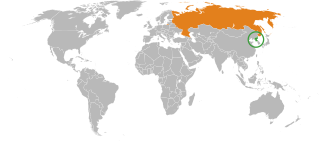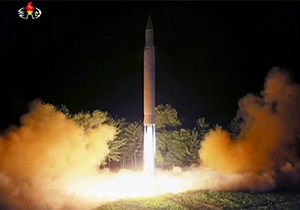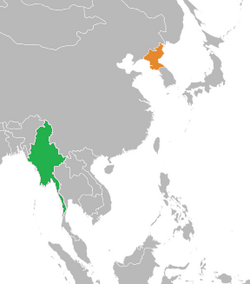
Historically strained, Myanmar's foreign relations, particularly with Western nations, have improved since 2012. Relations became strained once more in 2017 with the Rohingya crisis. Myanmar has generally maintained warmer relations with near states and is a member of the Association of Southeast Asian Nations.

North Korea has diplomatic relations with 164 states. The country's foreign relations have been dominated by its conflict with South Korea and its historical ties to the Soviet Union. Both the government of North Korea and the government of South Korea claim to be the sole legitimate government of the whole of Korea. The de facto end of the Korean War left North Korea in a military confrontation with South Korea along the Korean Demilitarized Zone.

North Korea has a military nuclear weapons program and, as of early 2020, is estimated to have an arsenal of approximately 30 to 40 nuclear weapons and sufficient production of fissile material for six to seven nuclear weapons per year. North Korea has also stockpiled a significant quantity of chemical and biological weapons. In 2003, North Korea withdrew from the Treaty on the Non-Proliferation of Nuclear Weapons (NPT). Since 2006, the country has been conducting a series of six nuclear tests at increasing levels of expertise, prompting the imposition of sanctions.

Relations between North Korea (DPRK) and the United States have been historically tense and hostile. The two countries have no formal diplomatic relations. Instead, they have adopted an indirect diplomatic arrangement using neutral intermediaries. The Swedish Embassy in Pyongyang is the US protecting power and provides limited consular services to U.S. citizens. The DPRK does not have an embassy in Washington, DC, but is represented in the United States through its mission to the United Nations in New York.

The Korean conflict is an ongoing conflict based on the division of Korea between North Korea and South Korea, both of which claim to be the sole legitimate government of all of Korea. During the Cold War, North Korea was backed by the Soviet Union, China, and other allies, while South Korea was backed by the United States, United Kingdom, and other Western allies.

Two rounds of North Korean missile tests were conducted on July 5, 2006. The Democratic People's Republic of Korea reportedly fired at least seven separate missiles. These included one long-range Taepodong-2 missile and short-range Scud derived missiles including the enlarged Nodong missile. The Taepodong-2 was estimated by United States intelligence agencies as having a potential range reaching as far as Alaska, although this missile failed after about 42 seconds of flight.

Iran–North Korea relations are described as being positive by official news agencies of the two countries. Diplomatic relations improved following the Iranian Revolution in 1979 and the establishment of an Islamic Republic. Iran and North Korea pledge cooperation in educational, scientific, and cultural spheres. Some media reports claim this cooperation extends to nuclear cooperation, though official U.S. government publications and academic studies have disputed this. The United States has been greatly concerned by North Korea's arms deals with Iran, which started during the 1980s with North Korea acting as a third party in arms deals between the Communist bloc and Iran, as well as selling domestically produced weapons to Iran, and North Korea continues selling missiles to Iran. North Korea and Iran are the remaining two members of George W. Bush's "Axis of evil", which has led to many of the concerns regarding Iran–North Korea relations.

Pakistan has both diplomatic and economic relationships with North Korea. The start of relations between the two countries emerged sometime in the 1970s during the democratic prime ministerialship of Prime Minister Zulfikar Ali Bhutto, when he made a state visit to North Korea as part of his foreign policy campaign to strengthen the relations with socialist states. Pakistan has an embassy in Pyongyang while North Korea maintains an embassy in Islamabad, a vast Consulate-General in Karachi, and consulates in other cities of Pakistan.

North Korea–Russia relations are the bilateral relations between Russia and North Korea. The Soviet Union was the first to recognize North Korea on October 12, 1948, shortly after the proclamation, as the sole legitimate authority in all of Korea. During the Korean War, the Korean People's Army was supported by the Soviet Armed Forces. North Korea was founded as part of the Communist bloc, and received major Soviet military and political support. The comprehensive personality cult around North Korea's ruling family was heavily influenced by Stalinism. China and the Soviet Union competed for influence in North Korea during the Sino-Soviet split in the 1960s, as North Korea tried to maintain good relations with both countries.

United Nations Security Council Resolution 1874 was adopted unanimously by the United Nations Security Council on 12 June 2009. The resolution, passed under Chapter VII, Article 41, of the UN Charter, imposes further economic and commercial sanctions on the Democratic People's Republic of Korea and encourages UN member states to search North Korean cargo, in the aftermath of an underground nuclear test conducted on 25 May 2009.
The following lists events that happened in 2013 in the Democratic People's Republic of Korea. In 2013, tensions between North Korea and South Korea, the United States, and Japan escalated because of United Nations Security Council Resolution 2087, which condemned North Korea for the launch of Kwangmyŏngsŏng-3 Unit 2. The crisis was marked by increased rhetoric by the new North Korean administration under Kim Jong-un and actions suggesting imminent nuclear attacks against South Korea, Japan, and the United States.
A number of countries and international bodies have imposed sanctions against North Korea. Currently, many sanctions are concerned with North Korea's nuclear weapons program and were imposed after its first nuclear test in 2006.
In the year 2017, North Korea was involved in the 2017 North Korea crisis, along with other events. The country conducted a nuclear test in September, and several missile tests throughout the year. One of these was the country's first successful test of an intercontinental ballistic missile (ICBM), Hwasong-14. Two missiles were launched over Hokkaido in the Japanese archipelago, in August and in September 2017.

The Academy of Sciences of the Democratic People's Republic of Korea or State Academy of Sciences, formerly the National Academy of Sciences, is the national academy of sciences of North Korea. It was founded in 1952, and until 1981 was responsible for all research conducted in the country before various organizational reforms and splittings of academies were conducted.

The 2017–18 North Korea crisis was a period of heightened tension between North Korea and the United States throughout 2017. The crisis began early in the year when North Korea conducted a series of missile and nuclear tests that demonstrated the country's ability to launch ballistic missiles beyond its immediate region, suggesting their nuclear weapons capability was developing at a faster rate than had been assessed by U.S. intelligence. Both countries started exchanging increasingly heated rhetoric, including nuclear threats and personal attacks between the two leaders, which, compounded by a joint U.S.–South Korea military exercise undertaken in August and North Korea's sixth nuclear test in September, raised international tensions in the region and beyond and stoked fears about a possible nuclear conflict between the two nations. In addition, North Korea also threatened Australia twice with nuclear strikes throughout the year for their allegiance with the United States.

Mexico–North Korea relations are the current and historical relations between Mexico and North Korea. In 2017, there were 366 North Koreans residing in Mexico.
The Myanmar Directorate of Defence Industries, commonly known as Directorate of Defence Industries, Karkweye Pyitsu Setyoun, or its Burmese abbreviation, Ka Pa Sa, is a state-owned enterprise that is officially part of the Tatmadaw. DI is responsible for producing military equipment throughout the country for the Myanmar Army, the Myanmar Navy and the Myanmar Air Force. It is the only company that has monopolized firearms production.

Myanmar–South Korea relations are the bilateral relations between the Republic of the Union of Myanmar and the Republic of Korea. The two countries established their diplomatic relations on 16 May 1975.

















